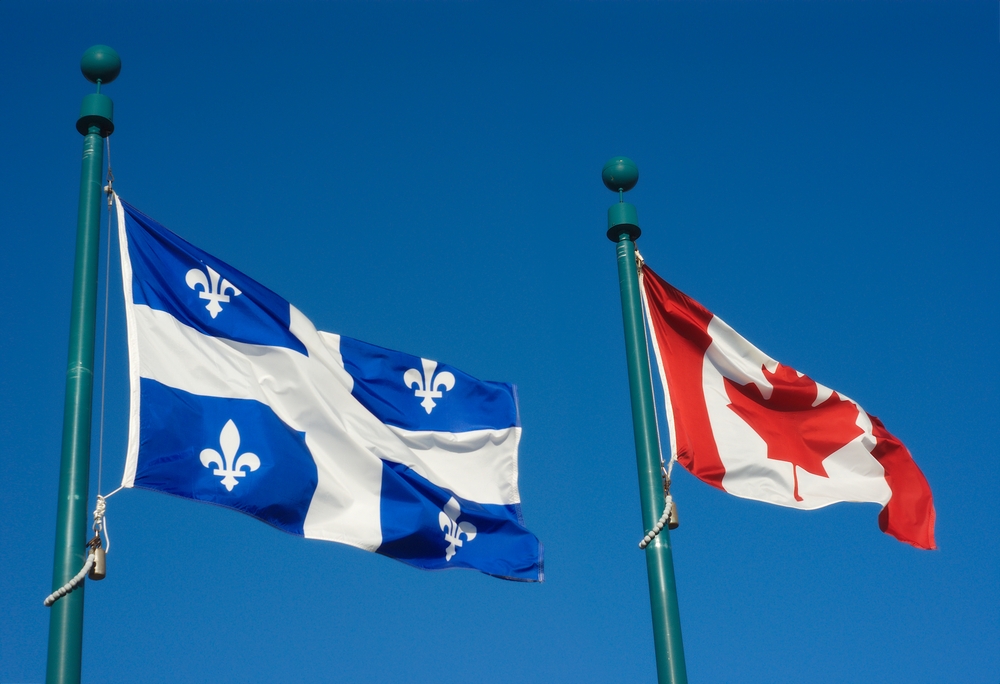on parle

Ready, seed, plant!
May 2023
While warm weather has been slow to arrive this spring, gardens are blooming across the province as Quebecers plant vegetable plots and fill their planters. Some residents of northern municipalities seem to be holding off, but most Quebecers spent the long weekend (National Patriots' Day in Quebec, Victoria Day in the rest of Canada) at the nursery, stocking up on fruit and vegetable seedlings, perennials, annuals, and herbs. If you’re doing the same, take a break from weeding to do some reading. When it comes to advertising, communications and culture, here’s what’s worth noting (in our humble opinion).

Québec says YES to independent bookstores!
I was strolling down the now pedestrianized Mont-Royal Avenue, slightly dazed by the buzz of the four-day weekend, when I noticed something that surprised me. Not one, not two, but four independent bookstores in a row, standing shoulder to shoulder against the adversity caused by mass retailers. That’s the image this harmonious quartet gave me, at least. I found it so beautiful; little neighbourhood bookstores where people can go to read, where authors can launch their novels (a lot of novels are launched in Plateau-Mont-Royal), and kids can let their imaginations loose in the children’s section while their parents enjoy a warm coffee from a nearby café (there are a lot of cafés in Plateau-Mont-Royal, as well).
With a little digging, I learned that there are currently around 160 independent bookstores in Québec. After a downturn at the beginning of 2010, indie booksellers have since experienced an impressive recovery, especially considering present-day challenges (such as Amazon and the rise of e-commerce). In eight years, no fewer than 13 new bookstores opened their doors, while 2021 saw a record number of eight bookstores open across the province. Not bad for a medium that was supposed to disappear with the advent of digital books.
So, how is David defeating Goliath, so to speak? By and large, independent bookstores have adapted their business model: physical spaces are smaller, though the space they hold in the community has grown—sometimes even making way for local farm products and coffee counters in their shops. Like I said, standing shoulder to shoulder against adversity.
Not only are bookstores thriving in Québec, libraries are too. Québec readers even have access to pretnumerique.ca, a digital library platform that offers a vast collection of books, audiobooks, and magazines in French.
Meanwhile, in the rest of Canada…
Unfortunately, I’ve heard through the grapevine that the same does not hold true across Canada. Why? First and foremost, large American publishers charge exorbitant fees that prohibit libraries outside Québec from offering adequate digital and audiobook collections to their patrons. The so-called "Big Five" publishers don’t sell their licenses for peanuts! They control the bulk of written works in the language of Shakespeare and sell digital rights to libraries at three-to-four times the average consumer price, in addition to imposing time limitations and other restrictions! In Québec, as we see time and again, our love of Quebecois culture engenders a form of solidarity. This amity between publishers and libraries allows the latter to offer privileged access to their catalogues because, as Dany Laferrière would say, "a good book always finds its way into the hands of a free reader."
- Valérie Forget, Adaptation Director

Building Bridges Between the Two Solitudes
We’ve been hearing about "two solitudes" for some time now. While Québec’s two referendums are long behind us, the disconnect and cultural distance between English- and French-speaking Canadians encompassed in this 1940s expression persists today. Here at the shop, we've been of course following this subject closely to ensure that we always get the facts straight for our partners. Recently, we’ve observed that the "two solitudes" phenomenon is evolving among younger generations as the cultural identity of Quebecers becomes more nuanced and complex.
Surrounded by English-speaking North America, Quebecers uphold French language and culture as a key part of their identity. Cultivating a sense of belonging in Canada has been, and still is, quite difficult. Not surprisingly, according to an early 2023 survey conducted by the Association for Canadian Studies (ACS), Anglophones’ attachment to Canada is similar to Francophones’ attachment to Québec. However, younger people (aged 18-24) show less interest in questions of national identity.
Within both solitudes, multiple drivers of change are influencing Québec’s younger generations, including the rise of bilingualism, cross-cultural interaction, multiculturalism and the widespread use of communication platforms. Not to mention that young Quebecers and Canadians often share common values, including open-mindedness, equality, diversity and social justice. These shared values can help build bridges and overcome the divide between the two communities.
Conversely, the ACS survey shows that an increasing number of French- and English-speaking Quebecers are in favour of state secularism, but French speakers are even more positive than English speakers (60% vs. 33%) about the neutrality of the state towards all religions (including Catholicism) and its manifestations/symbols.
Francophones appear to be less supportive of multiculturalism than their Anglophone counterparts (61% vs. 76%). However, positions adopted by Quebecers today appear more nuanced. Although many are inclined to think that both beliefs are mutually exclusive, one can be in favour of multiculturalism, yet also support secularism.
Lastly, although English-speaking and French-speaking Canadians have come together on certain issues in recent years, it remains essential to understand and appreciate the differences and complexities of Quebecois culture. To avoid missteps, localization has and will always have a place in the Québec market for any advertiser who intends to connect with audiences and have an impact.
Bianca Lacasse, Account Director

Local Media at the Heart of an Industry-Wide Discussion
Flashback to spring 2020. The pandemic is in full swing. Most sectors of the economy have slowed down considerably, and many companies know they will not survive. Much like in every other economic crisis, advertising is one of the firsts industries to undergo major budget cuts, directly affecting media revenues. Meanwhile, persistent advertisers who took advantage of the change in consumer behaviours move towards “tried-and-true” media platforms, as marketing executives are more obsessed than ever with a flawless ROI.
Mouvement Média d’Ici was born from these circumstances, amid debates on the importance of buying local, minimizing unemployment, and stimulating the economy (or, in other words, saving our future). The initiative was launched in May 2020 by L’Association des agences de communication créative (A2C) and partly pioneered by Jungle Media.
Although advertising investments have been shifting to digital media and its global players (Google, Meta, Amazon, etc.) since well before the pandemic, the events shed a new light on the issue. Now, many agencies and advertisers automatically rely on those platforms, clearly at the expense of local media, as it reduces their capacity to create original profitable and relevant content on a recurring basis. According to IAB Canada data, if 50% of media budgets are allocated to the purchase of digital media, it prevents 86% of those same investments from being granted to local media, leaving a meagre 14% to our ecosystem.
The Mouvement advocates for agency self-accountability. By signing the manifesto, it compels them to make most of their investments in local media, whether digital or traditional. It is measurable through an index that is clearly visible on all media plans, showing the percentage invested in local media. Today, most media plans produced by Jungle Media highlight this precept. First, by using the index, but also by advocating for local media through education and awareness. There was an industry-wide wake-up call, and an efficient one, to say the least. Investments made in local media for digital advertising went from 14% to 34% between 2020 and 2021. Incidentally, the Mouvement had the objective of doubling those investments in their first three years, reaching a 200-million-dollar plateau.
Today, the Mouvement’s biggest challenge continues to be the investors’ natural tendency to rule out local media, voluntarily or not, based on efficiency and performance. By doing so, they are neglecting substantial aspects of communications such as engagement and belonging, as well as the inherent relationships often maintained between advertisers, media, and consumers. This shift cannot happen without advertisers’ support and willingness to ensure an equitable distribution of their media investments among local media, as well as an open discussion with their agencies. These companies’ future is at stake and so is our own media landscape—a francophone ecosystem unlike any other in the world considering its geopolitical situation.
- Marc Hamelin, Media Director, Jungle

TFS Shoots and Scores for Tim Hortons
For the past five years, The French Shop has had fun adapting Tim Hortons’ national campaigns for the French-speaking market in Québec. Whether we’re helping to announce a new donut flavour or encouraging people to give generously on Camp Day, there’s no shortage of opportunities for our client to strike a chord with Quebecers, and our team embraces every mandate with equal parts pleasure and professionalism.
The latest campaign promoting NHL trading cards is no exception. Over the years, Tims has enlisted many hockey stars to appear in its commercials, including most recently, Sidney Crosby, Nathan MacKinnon, Sarah Nurse and Marie-Philip Poulin. In 2023, a more nostalgic lineup is on the menu; this year’s cards feature former NHL and women’s hockey players.
TFS was asked to adapt a television and digital advertising campaign created by the Toronto-based agency GUT into French. This was no small feat, as the English concept featured Wayne Gretzky and Hayley Wickenheiser. Some will remember the JOFA ad (1981) starring a less than fluent French-speaking Gretzky and the RBO parody that followed… For the Québec market, going this route again was out of the question.
As an inventive solution, TFS opted to recreate the same story, but with a homegrown hockey star whose career would resonate with Québec audiences. Among the recommended Quebec players gathered by TFS, Tim Hortons narrowed their choice to one of the greatest defensemen in NHL history: the one and only Raymond Bourque.
To enhance authenticity and reach the greatest number of hockey fans across the province, the team enlisted actor Alain Cadieux—the man with one thousand and one voices—to re-record the words of a commentator and recreate the exciting atmosphere of a symbolic moment in hockey history. The entire sequence was accompanied by a voiceover recorded by none other than sports journalist Alain Crête, a longtime TFS collaborator on Tim Hortons’ hockey spots.
Following TFS’s recommendation, The Great One makes an appearance in the commercials for the French market, and the interplay between Gretzky and Bourque makes the story all the more compelling. Watch the two in action, here, here and here.
Hockey rules may be the same around the world, but to reach your audience, it’s important to localize your message. As this Tim Hortons campaign proves, that doesn’t always happen in the language of Molière.
Joëlle Fournier, V.P. Creative, and Béatrice Réa, Copywriter
